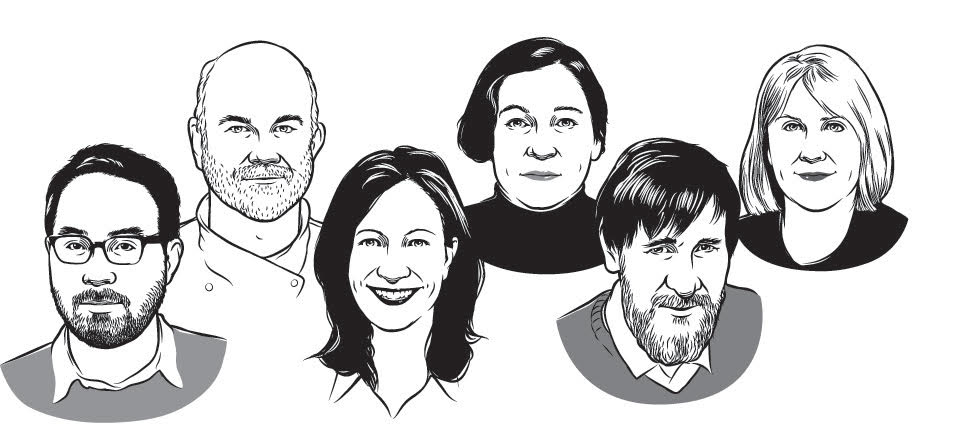From illustrators to editors and everything in between
Adrian Tomine

In his cover illustrations for the New Yorker, Adrian Tomine ’96 has created some of the most iconic images of life under quarantine, including “Love Life,” from Dec. 7, 2020, which showed a young woman on a Zoom date, holding a cocktail and dressed to kill—from the waist up. Not visible to her date are soccer shorts and unshaven legs, not to mention the cats, clutter, and chaos of her cramped apartment. Tomine is the author of the best-selling and widely acclaimed 2015 graphic novel Killing and Dying and the illustrated memoir The Loneliness of the Long-Distance Cartoonist (2020).
Bill Buford

Before joining the New Yorker, Bill Buford ’77 was, for 16 years, editor of the literary journal Granta, where he coined the term “dirty realism” to describe a generation of authors writing about “the belly-side of contemporary life.” Buford himself is probably best known for laying bare the belly-side of English life in his book Among the Thugs (1990), about that country’s football hooligans. Buford was fiction editor of the New Yorker from 1995 to 2002, a position the Times said “carries clout equivalent to St. Peter’s at the Pearly Gates”—at least in the minds of aspiring writers. Buford is still an occasional contributor to the New Yorker, now mostly writing about food. His most recent book, Dirt (2020), chronicles his quest to master French cooking.
Deborah Treisman

Deborah Treisman ’91 got her first rejection letter from the New Yorker at age 11. She graduated from Berkeley in comparative literature at 16. In 2003, she became the youngest person to be named fiction editor at the New Yorker, the same magazine that had rejected her younger self. Treisman rose to the spot after a stint as deputy under fellow Cal alum Bill Buford. She was raised in a family of high achievers; her mother, Anne Treisman, was a renowned psychologist who taught at Berkeley for many years, as did her stepfather, the Nobel Prize-winning economist and psychologist Daniel Kahneman, Ph.D. ’61. Of her own august position in literary Valhalla, Treisman has said, “This is a great job, but it’s a job.”
Joan Acocella

Joan Acocella ’66, who graduated from Berkeley as Joan Ross, has been a staff writer at the New Yorker since 1995 and for many years was the magazine’s dance critic. In 2005, she delivered a lecture at Berkeley’s Townsend Center for the Humanities called “Ballet and Sex.” She began the talk by saying that she had mistitled it. What she actually wanted to discuss was the “use of the female crotch and its armature in classical ballet.” She lost her courage, she said, when she thought about that title—“Ballet and the Crotch”—appearing on a flyer. “Nevertheless, that is my subject.”
Mike Twohy

Longtime New Yorker cartoonist Mike Twohy, MFA ’73, provided the raw material for the magazine’s first-ever caption contest in 1998. His drawing depicted a lab scientist and rats, the researcher himself dressed in a giant rat suit. The winning caption: “More important is what I learned about myself.” These days, Twohy mostly devotes himself to writing and illustrating children’s books. His titles include Outfoxed, Mouse and Hippo, and Spacebot. His most recent New Yorker contribution was an illustrated “Shouts and Murmurs” collaboration with daughter Clare about pandemic life, titled “Places Beyond Boredom.” First stop: “Charades-for-one bored.”
Margaret Talbot

A proud alumna of the Daily Californian, where she once served as editor-in-chief, Margaret Talbot ’84 joined the New Yorker as a staff writer in 2004 after stints at the New York Times Magazine, the New Republic, and Lingua Franca. She is the youngest daughter of the late screen actor Lyle Talbot, the subject of her 2012 book, The Entertainer: Movies, Magic, and My Father’s Twentieth Century. Her newest work, released in June, is a collaboration with brother David Talbot, founding editor of Salon, called By the Light of Burning Dreams. Kirkus calls it “an intelligent and sympathetic reappraisal of the political upheavals of the ’60s and ’70s.”
From the Fall 2021 issue of California.


















